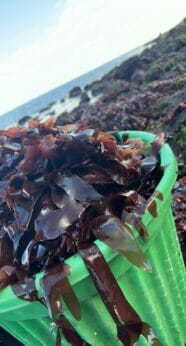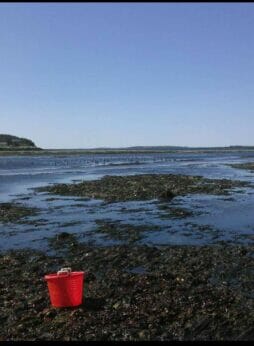The Ebbing Tide of Dulse
A skill passed down through generations, dulsing isn’t what it used to be on New Brunswick’s Grand Manan Island.
The Ebbing Tide of Dulse
A skill passed down through generations, dulsing isn’t what it used to be on New Brunswick’s Grand Manan Island.

Dulse drying in the sun on Grand Manan.courtesy of Noah Leonard.
It’s low tide and the dories are heading out to sea from New Brunswick’s Grand Manan Island, along Canada’s east coast. Dulsers will spend the next six hours scouring outlying beaches and handpicking the sea vegetable off the exposed ocean floor. This is the way it’s always been done on Grand Manan.
With a population of approximately 2,700, almost everyone on the island has dulsed. Your parents or grandparents were dulsers, you’ve harvested or you know someone who does. It’s one of the Island’s identifiers. But there have been changes recently. “There are good years and bad,” says Bonnie Morse, mayor of Grand Manan. “Dulse isn’t as reliable as it once was.”

Located at the entrance of the Bay of Fundy, the island of Grand Manan is a 90-minute ferry ride from New Brunswick’s mainland. Everything on the tiny 24-kilometre-long enclave depends on the sea. In bad weather, the ferry doesn’t come. When the water is calm, tourists arrive to marvel at panoramic ocean views and tiny hamlets where, like in the old days, no one locks their door at night. It creates a protectiveness in islanders towards what the sea provides — especially the dulse. There’s also lobster, herring, scallops and crab to supply Grand Mananers with a steady ocean diet.
Most people outside of Canada’s maritime provinces have never heard of or tasted dulse, the chewy, umami-tasting purple seaweed with an ocean smell. A 21st-century superfood, dulse contains high concentrations of iodine and is loaded with vitamins B, C and A, potassium and calcium. The purity and quality of Grand Manan dulse is sought after by nutraceutical and vitamin manufacturers. On Grand Manan, dulse is added to chowders, stews and pretty much everything in between. Growing in the lower intertidal zones of the North Pacific and Atlantic oceans, it’s one of the world’s oldest foods. Monks on Scotland’s Island of Iona ate it 1,400 years ago. In Iceland, it’s called söl and is a source of dietary fibre. But ask any self-respecting Grand Mananer and they’ll say their dulse is the world’s best. Matthew Abbott of the Conservation Council of New Brunswick credits the tide. “It gives dulse its Grand Manan edge.”
Bay of Fundy tides are the strongest in the world. At peak flood, the water rushing past Grand Manan is 25 million cubic meters per second. The sheer force churns up the seabed, feeding the dulse a steady diet of minerals and nutrients. At low tide on the west side of the island, 200-foot cliffs cast shadows that shade the dulse from the sun and bleach out all that tidal goodness. They’ve been dulse’s secret ingredient — until now.
Typically harvested between June and October, dulse is a finicky crop. It needs a water temperature of between 5 and 14 degrees Celsius to reproduce. The Bay of Fundy averages between 5 and 12 Celsius. But for how long? Climate change is not only heating the atmosphere but the ocean. In 2021, temperatures in the Bay of Fundy were 2.3 degrees above average. “It’s terribly unfortunate,” says Abbot. “It’s the fastest-warming water on the planet.”
But it’s the rock rollers, as Grand Mananers call them, that really do damage. Violent storms cause the sea to overturn the rocks into which the dulse is suckered and ripped to shreds. Climate change has altered weather patterns and once-in-a-decade storms are seemingly yearly now. The slow-growing dulse can’t recover between volleys.
Abbot’s job is to look for ways to protect the shoreline from the ocean’s powerful churn. “There are environmental impact studies and research to be done, but artificial reefs anchoring the dulse in place and preventing a rock roller from doing harm is one idea.”
Atlantic Mariculture, a Grand Manan company that provides dulsers with a market for their haul, is also looking for solutions. Jay J. Botes, marketing and communications lead for the company, says that if the natural environment was too inhospitable for dulse, they may be able to grow it indoors. “I would expect to see dulse being cultivated in land tanks that could mimic the conditions of the wild.”
As conditions change along Grand Manan, Atlantic Mariculture has had to diversify its product line. Popular sea vegetables such as rockweed and nori also cling to Grand Manan’s shores. They are slightly less dependent upon location and water temperature, giving the company a more dependable crop and opportunity for harvesters.

Grand Mananers have been through this type of decline before. The herring industry used to employ Grand Mananers, says Morse, but when it declined, it was lobster and dulse that anchored people.
“People stayed. They built a life, had children and retired on dulse,” says Morse. “This generation doesn’t see dulsing as a viable career. They’re turning to the mainland for jobs or the more lucrative lobster fishery. They harvest now to supplement other income.”
Morse hopes this will be a good year for dulse. There weren’t rock rollers this winter and the water is cold. The dories still come and go from Grand Manan. But for how long?
Follow us
This work is licensed under a Creative Commons Attribution-NoDerivatives 4.0 International License.
Want to republish a Modern Farmer story?
We are happy for Modern Farmer stories to be shared, and encourage you to republish our articles for your audience. When doing so, we ask that you follow these guidelines:
Please credit us and our writers
For the author byline, please use “Author Name, Modern Farmer.” At the top of our stories, if on the web, please include this text and link: “This story was originally published by Modern Farmer.”
Please make sure to include a link back to either our home page or the article URL.
At the bottom of the story, please include the following text:
“Modern Farmer is a nonprofit initiative dedicated to raising awareness and catalyzing action at the intersection of food, agriculture, and society. Read more at <link>Modern Farmer</link>.”
Use our widget
We’d like to be able to track our stories, so we ask that if you republish our content, you do so using our widget (located on the left hand side of the article). The HTML code has a built-in tracker that tells us the data and domain where the story was published, as well as view counts.
Check the image requirements
It’s your responsibility to confirm you're licensed to republish images in our articles. Some images, such as those from commercial providers, don't allow their images to be republished without permission or payment. Copyright terms are generally listed in the image caption and attribution. You are welcome to omit our images or substitute with your own. Charts and interactive graphics follow the same rules.
Don’t change too much. Or, ask us first.
Articles must be republished in their entirety. It’s okay to change references to time (“today” to “yesterday”) or location (“Iowa City, IA” to “here”). But please keep everything else the same.
If you feel strongly that a more material edit needs to be made, get in touch with us at [email protected]. We’re happy to discuss it with the original author, but we must have prior approval for changes before publication.
Special cases
Extracts. You may run the first few lines or paragraphs of the article and then say: “Read the full article at Modern Farmer” with a link back to the original article.
Quotes. You may quote authors provided you include a link back to the article URL.
Translations. These require writer approval. To inquire about translation of a Modern Farmer article, contact us at [email protected]
Signed consent / copyright release forms. These are not required, provided you are following these guidelines.
Print. Articles can be republished in print under these same rules, with the exception that you do not need to include the links.
Tag us
When sharing the story on social media, please tag us using the following: - Twitter (@ModFarm) - Facebook (@ModernFarmerMedia) - Instagram (@modfarm)
Use our content respectfully
Modern Farmer is a nonprofit and as such we share our content for free and in good faith in order to reach new audiences. Respectfully,
No selling ads against our stories. It’s okay to put our stories on pages with ads.
Don’t republish our material wholesale, or automatically; you need to select stories to be republished individually.
You have no rights to sell, license, syndicate, or otherwise represent yourself as the authorized owner of our material to any third parties. This means that you cannot actively publish or submit our work for syndication to third party platforms or apps like Apple News or Google News. We understand that publishers cannot fully control when certain third parties automatically summarize or crawl content from publishers’ own sites.
Keep in touch
We want to hear from you if you love Modern Farmer content, have a collaboration idea, or anything else to share. As a nonprofit outlet, we work in service of our community and are always open to comments, feedback, and ideas. Contact us at [email protected].by Jennifer Cole, Modern Farmer
April 17, 2023
Modern Farmer Weekly
Solutions Hub
Innovations, ideas and inspiration. Actionable solutions for a resilient food system.
ExploreExplore other topics
Share With Us
We want to hear from Modern Farmer readers who have thoughtful commentary, actionable solutions, or helpful ideas to share.
SubmitNecessary cookies are absolutely essential for the website to function properly. This category only includes cookies that ensures basic functionalities and security features of the website. These cookies do not store any personal information.
Any cookies that may not be particularly necessary for the website to function and are used specifically to collect user personal data via analytics, ads, other embedded contents are termed as non-necessary cookies.